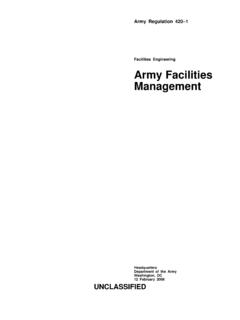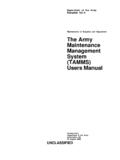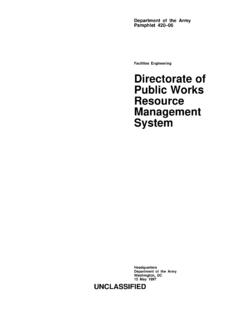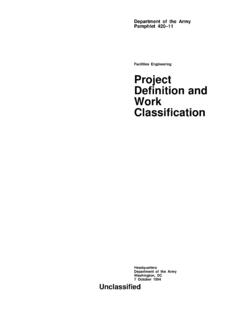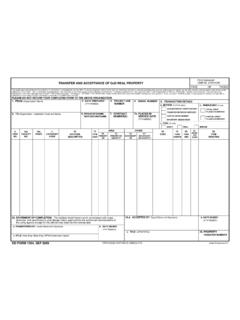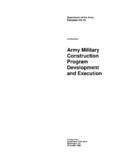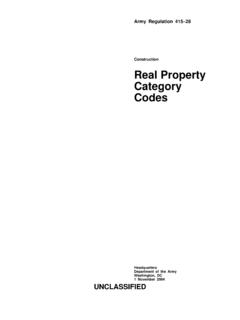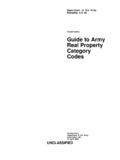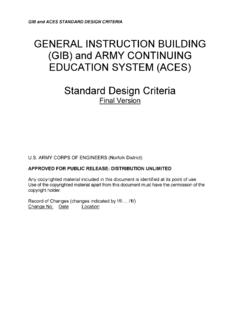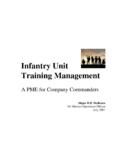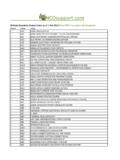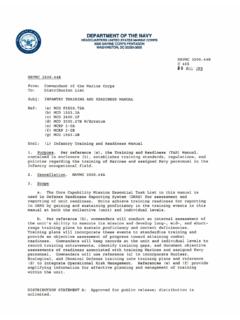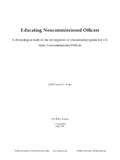Transcription of Training Land - rubiconplanning
1 TC 25-1 Training land MARCH 2004 HEADQUARTERS DEPARTMENT OF THE ARMY DISTRIBUTION RESTRICTION: Approved for public release; distribution is unlimited. This publication is available at Army Knowledge Online Training Circular No. 25-1 Headquarters Department of the Army Washington, DC, 15 March 2004 Training land Contents Page Chapter 1 THE ARMY NEEDS MANEUVER/ Training 1-1 1-1. 1-2. Purpose of this Training 1-3. Historical 1-4. Army 1-5. Training the 1-6. Maneuver/ Training Areas for Reserve Components and 1-7.
2 Manuever/ Training Areas for Deployed 1-8. Testing Ranges and 1-9. Maneuver/ Training Area Chapter 2 USING AND SUSTAINING MANEUVER/ Training 2-2. 2-2. Commanders Maneuver land Range Program (SRP)..2-2 Chapter 3 MANEUVER/ Training AREA STRATEGY AND 3-1. 3-2. The Range and Training land 3-3. Range and Training land Program (RTLP) 3-4. Installation Analysis and 3-5. Maneuver/ Training Area 3-6. Range and Surface Danger Zone (SDZ) Requirements and Impact 3-7. Mobilization 3-8. Unusable Installation 3-9. Maneuver/ Training Area 3-10.
3 Maneuver/ Training Areas and the 3-11. Geospatial Information System (GIS) 3-6 Distribution Restriction: Approved for public release; distribution is unlimited. *This publication supersedes TC 25-1, 25 June 2001. TC 25-1 ii Appendix A UNIT MANEUVER/ Training AREA Appendix B INSTITUTIONAL MANEUVER/ Training AREA Appendix C OPERATIONAL FORCES Appendix D INSTALLATION FIGURES Figure Force maneuver/ Training area requirments (flowing scenario)..A-2 Figure A-2. Non-contiguous maneuver areas, footprints, and Figure A-3. Aviation unit contiguous/non-contiguous deliberate attack maneuver area Figure A-4.
4 Aviation unit contiguous/non-contiguous air assault maneuver area Figure C-1. BCT maneuver/ Training requirements (isolated events)..C-1 Figure C-2 BCT maneuver/ Training area requirements (flowing scenario)..C-2 Figure C-3. FSB maneuver/ Training area requirements ( Training independently)..C-3 Figure C-4. Area of Operation and Area of Figure C-5. SBCT maneuver/ Training area TABLES Table 3-2. Potential constraints on usable Training Table A-1. Mechanized Infantry and Armor Division Maneuver/ Training Area Table A- 2. Light Division Maneuver/ Training area Table A-3.
5 Maneuver/ Training area Requirements for Selected Units at Echelons above Table A-4. Maneuver/ Training Area Requirements for the Stryker Brigade Combat Team (SBCT)..A-53 Table B-1. Institutional POI Maneuver Area Table C-1. UA iii Preface This Training circular incorporates changes to Training Circular 25- 1, Training land . These changes: Provide commanders and staffs a sound basis for understanding the changes in maneuver/ Training area use and management generated by Army Transformation. There are new management structures, new units and Training doctrine and new pressures on sustaining existing maneuver/ Training areas.
6 (Chapter 1) Describe the Army s Sustainable Range Program (SRP) goals and objectives for maneuver/ Training ar-eas. (Chapter 2) Explain the proposed Army Range and land Strategy, and how it supports land acquisition and Army Compatible Use Buffers (ACUB) (Chapter 3) Identify two additional environmental considerations that support regulatory compliance, land stew-ardship, and Army Training . (Chapter 3) Update current unit maneuver/ Training area requirements based on Mission Training Plans (MTP) and Combined Arms Training Strategies (CATS).
7 (Appendix A) Introduce Stryker Brigade Combat Team (SBCT) maneuver/ Training area requirements based on MTPs and CATS. (Appendix A, Table A- 4) Update the Institutional maneuver/ Training area requirements. (Appendix B) Provide a first look at the Future Force s Unit of Action (UA) maneuver/ Training area requirements. As Transformation Forces strategies evolve, further updates will be required. (Appendix C) Discuss contiguous and non-contiguous maneuver areas and connectivity among non-contiguous areas. (Appendix C) Provide a link to Training maps for selected installations.
8 (Appendix D) Maneuver/ Training area requirements (identified in this circular) for Army units are based on Army Training and Evaluation Program Mission Training Plans. These documents provide the solid doctrinal base from which unit commanders develop their unit Training strategies to train their units for combat. Army operational missions are conducted in a joint environment, and Army operational Training will increas-ingly include the integration of the other Service s land , air and sea capabilities and maneuver/ Training area re-quirements.
9 Maneuver/ Training area land requirements for joint operations have not yet been developed, but will be addressed in future updates. It is the primary purpose of this circular to state the Army s core require-ments. The proponent for this publication is the US Army Training Support Center, Fort Eustis, VA. Submit comments and recommendations on DA Form 2028 (Recommended Changes to Publications and Blank Forms) directly to Commander, USATSC, ATTN: ATIC-ATML, Fort Eustis, VA 23604. Unless this publication states otherwise, masculine nouns or pronouns do not refer exclusively to men.
10 1-1 Chapter 1 The Army Needs Maneuver/ Training Areas Every day, the Army trains soldiers and units while developing leaders. Effective Training is the cornerstone of operational to high standards is es-sential for a full spectrum force: Army forces must train to, and maintain, the highest readiness levels. FM 3-0, Operations, June 2001. 1-1. Introduction. The mission of the Army is to defend the homeland, promote security and deter aggression, fight and win the nation s wars, and ensure superiority over enemy forces.

